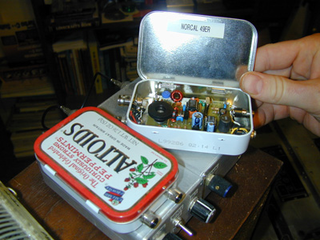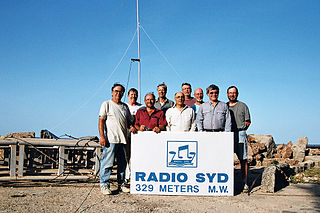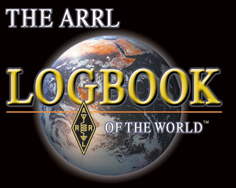Related Research Articles

In amateur radio, QRP operation refers to transmitting at reduced power while attempting to maximize one's effective range. QRP operation is a specialized pursuit within the hobby that was first popularized in the early 1920s. QRP operators limit their transmitted RF output power to 5 W or less regardless of mode.

Radioteletype (RTTY) is a telecommunications system consisting originally of two or more electromechanical teleprinters in different locations connected by radio rather than a wired link. Radioteletype evolved from earlier landline teleprinter operations that began in the mid-1800s. The US Navy Department successfully tested printing telegraphy between an airplane and ground radio station in 1922. Later that year, the Radio Corporation of America successfully tested printing telegraphy via their Chatham, Massachusetts, radio station to the R.M.S. Majestic. Commercial RTTY systems were in active service between San Francisco and Honolulu as early as April 1932 and between San Francisco and New York City by 1934. The US military used radioteletype in the 1930s and expanded this usage during World War II. From the 1980s, teleprinters were replaced by personal computers (PCs) running software to emulate teleprinters.
The American Radio Relay League (ARRL) is the largest membership association of amateur radio enthusiasts in the United States. ARRL is a non-profit organization and was co-founded on April 6, 1914, by Hiram Percy Maxim and Clarence D. Tuska of Hartford, Connecticut. The ARRL represents the interests of amateur radio operators before federal regulatory bodies, provides technical advice and assistance to amateur radio enthusiasts, supports a number of educational programs and sponsors emergency communications service throughout the country. The ARRL has approximately 161,000 members. In addition to members in the US, the organization claims over 7,000 members in other countries. The ARRL publishes many books and a monthly membership journal called QST.

A DX-pedition is an expedition to what is considered an exotic place by amateur radio operators and DX listeners, typically because of its remoteness, access restrictions, or simply because there are very few radio amateurs active from that place. This could be an island, a country, or even a particular spot on a geographical grid. DX is a telegraphic shorthand for "distance" or "distant".
DXing, taken from DX, the telegraphic shorthand for "distance" or "distant", is the hobby of receiving and identifying distant radio or television signals, or making two-way radio contact with distant stations in amateur radio, citizens band radio or other two-way radio communications. Many DXers also attempt to obtain written verifications of reception or contact, sometimes referred to as "QSLs" or "veries".

Contesting is a competitive activity pursued by amateur radio operators. In a contest, an amateur radio station, which may be operated by an individual or a team, seeks to contact as many other amateur radio stations as possible in a given period of time and exchange information. Rules for each competition define the amateur radio bands, the mode of communication that may be used, and the kind of information that must be exchanged. The contacts made during the contest contribute to a score by which stations are ranked. Contest sponsors publish the results in magazines and on web sites.

An amateur radio station is a radio station designed to provide radiocommunications in the amateur radio service for an amateur radio operator. Radio amateurs build and operate several types of amateur radio stations, including fixed ground stations, mobile stations, space stations, and temporary field stations. A slang term often used for an amateur station's location is the shack, named after the small enclosures added to the upperworks of naval ships to hold early radio equipment and batteries.

An amateur radio operating award is earned by an amateur radio operator for establishing two-way communication with other amateur radio stations. Awards are sponsored by national amateur radio societies, radio enthusiast magazines, or amateur radio clubs, and aim to promote activity on the amateur radio bands. Each award has its own set of rules and fees. Some awards require the amateur radio operator to have contacted other stations in a certain number of countries, Maidenhead grid locators, or counties. Because amateur radio operators are forbidden by regulation to accept financial compensation for their on-air activity, award recipients generally only receive a certificate, wooden plaque, or a small trophy as recognition of their award.
Summits On The Air (SOTA) is an amateur radio operating award program launched in Great Britain in 2002 by John Linford.

A QSL card is a written confirmation of either a two-way radiocommunication between two amateur radio or citizens band stations; a one-way reception of a signal from an AM radio, FM radio, television or shortwave broadcasting station; or the reception of a two-way radiocommunication by a third party listener. A typical QSL card is the same size and made from the same material as a typical postcard, and most are sent through the mail as such.

Vintage amateur radio is a subset of amateur radio hobby where enthusiasts collect, restore, preserve, build, and operate amateur radio equipment from bygone years, such as those using vacuum tube technology. Popular modes of operation include speaking over amplitude modulation (AM), and communicating using Morse code through continuous wave (CW) radiotelegraphy. Some enthusiasts have interest in owning, restoring and operating vintage military and commercial radio equipment such as those from 1940s to 1960s. Some undertake to construct their own gear, known in ham slang as homebrewing, using vintage parts and designs. A number of amateur radio clubs and organizations sponsor contests, events, and swap meets that cater to this specialized aspect of the hobby.

Logbook of the World (LoTW) is a web-accessed database provided by the American Radio Relay League (ARRL) to implement a contact verification service among amateur radio operators. Using LoTW, radio amateurs (hams) are able to claim and verify contacts (QSOs) made with other amateurs, generally for claiming credit for operating awards, such as DXCC. Previously, hams had to rely on paper QSL cards and submit to ARRL; a slow and somewhat expensive process. LoTW began operation in 2003.
The history of amateur radio, dates from the dawn of radio communications, with published instructions for building simple wireless sets appearing at the beginning of the twentieth century. Throughout its history, amateur radio enthusiasts have made significant contributions to science, engineering, industry, and social services. Research by amateur radio operators has founded new industries, built economies, empowered nations, and saved lives in times of emergency.

Amateur radio operators take part in portable operations using radio equipment when traveling. "Portable" equipment indicates a configuration that allows for relatively rapid collection, transportation, and deployment of amateur radio gear. A portable station can be anything from a small QRP radio and antenna, to a large transceiver. On long-distance expeditions, such equipment allows them to report progress, arrivals and sometimes exchanging safety messages along the way.
Homebrew is an amateur radio slang term for home-built, noncommercial radio equipment. Design and construction of equipment from first principles is valued by amateur radio hobbyists, known as "hams", for educational value, and to allow experimentation and development of techniques or levels of performance not readily available as commercial products. Some items can be home-brewed at similar or lower cost than purchased equivalents.

CQ Amateur Radio is a magazine for amateur radio enthusiasts first published in 1945. The English language edition is read worldwide; Spanish language edition is published in Spain, with some translations of articles from the English language edition, and some original European content. The magazine was also published in France with partial translation of the original edition between 1995–2000. Published by CQ Communications, the title is based on the radio call "CQ".
An amateur radio net, or simply ham net, is an "on-the-air" gathering of amateur radio operators. Most nets convene on a regular schedule and specific frequency, and are organized for a particular purpose, such as relaying messages, discussing a common topic of interest, in severe weather, emergencies, or simply as a regular gathering of friends for conversation.

Amateur radio, also known as ham radio, is the use of the radio frequency spectrum for purposes of non-commercial exchange of messages, wireless experimentation, self-training, private recreation, radiosport, contesting, and emergency communications. The term "amateur" is used to specify "a duly authorized person interested in radioelectric practice with a purely personal aim and without pecuniary interest" ; and to differentiate it from commercial broadcasting, public safety, or professional two-way radio services.

Marshall D. Moran was born in Chicago on May 29, 1906, and died April 14, 1992, in Delhi, India. He was an American Jesuit priest, missionary in India and Nepal, where he founded several schools, amongst them the St. Xavier's High School, Patna, and the St. Xavier's School school of Lalitpur.

QRZ.com is an amateur radio website listing almost every callsign in the world. In 1992, QRZ founder Fred L. Lloyd accessed data from the FCC database to create a CD-ROM with all call signs issued in the United States. A copy of the CD-ROM is carried on board the International Space Station and one was also aboard the Russian Mir space station. QRZ.com is one of the most recognized websites for amateur radio enthusiasts. Information is pulled directly from the FCC database and from on-line databases of other nations, when available. Registered users can edit their data for accuracy and currency and many list additional information about their station, antennas and other life interests.
References
- ↑ H. Ward Silver (2 March 2018). Ham Radio For Dummies. Wiley. pp. 12–. ISBN 978-1-119-45482-3.
- ↑ W4QA, Rush (2013-03-13). "3 dB: A New One..." 3 dB. Retrieved 2024-09-14.
{{cite web}}: CS1 maint: numeric names: authors list (link) - 1 2 Harry L. Helms (1992). All about Ham Radio. HighText Publications. ISBN 978-1-878707-04-8.
- ↑ H. Ward Silver (2006). The ARRL Ham Radio License Manual: All You Need to Become an Amateur Radio Operator. Technician; Level 1. American Radio Relay League. pp. 4–. ISBN 978-0-87259-963-5.
- ↑ Danny Gregory; Paul Sahre (March 2003). Hello World: A Life in Ham Radio. Princeton Architectural Press. ISBN 978-1-56898-281-6.
